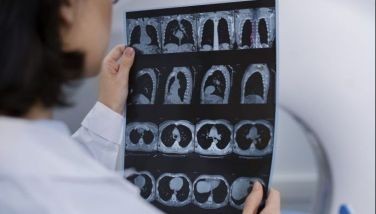Lights, camera & how Philippine TV began
September 29, 2003 | 12:00am
Fifty years ago, on September 21, 1953 at 6:15 p.m., the late Vero Perfecto and I hosted the first local TV broadcast on DZAQ-TV Channel 3 (AQ stood for Antonio Quirino), the first commercial television station in the Philippines.
Our maiden broadcast was aired from the residence of the late Judge Antonio Quirino on Guevara St., San Juan, where a garden party was in progress. We had no program script, no preparation whatsoever. Vero and I just agreed to do it spontaneously and hoped our errors and fluffs would be few and far between.
As it turned out, it wasn’t so bad. Sure, we had many wrong cues but Vero was a master of improvisation and somehow I managed to ride along. Using only one black and white orthicon camera mounted on a tripod, our TV technician panned the camera from left to right all evening to show the more than 300 socialites gathered. Without a floor director to give us signals, our cameraman would pan back to Vero and me as we made one-liner jokes a la Bob Hope. We were quite hilarious.
It was a soft opening without any fanfare. There was no press conference or special program with dancing girls to mark the first official telecast the way new product launchings are done today. We had 10 national advertisers to sponsor the show even though there must have been only 200 black and white TV sets throughout the country at the time.
We captured the evening’s program with a children’s show and some classical Kundiman songs rendered by a popular soprano whose name I cannot remember. We signed off at around 9:30 p.m. after inviting the guests and televiewers to "tune in again at 6 p.m. tomorrow for that classic movie The Count of Monte Cristo." I was afraid Judge Quirino would end the telecast with an appeal to reelect his brother, then president Elpidio Quirino, but to his credit he did not do so.
In the next six months after that initial TV broadcast, the job of sustaining a four-hour daily program from 6 p.m. to 10 p.m. was absolutely chaotic. Unlike today where you could import a Meteor Garden or a Thalia telenovela, television was not that advanced even in the USA. It was not until years later that companies like Desilu, the organization owned by Lucille Ball and Desi Arnaz, concentrated on the creation and production of syndicated film shows such as I Love Lucy and The Californians.
In the mornings I would call on the foreign embassies, oil companies, academic institutions and film distributors to borrow 16mm black and white films and schedule these for the day’s programming. Many of the films were cartoons like Popeye The Sailor, Mickey Mouse or Donald Duck. Sometimes I would schedule employee relations films like "Telephone Etiquette" or "How to Deal with Subordinates." Occasionally I would be lucky to borrow The Three Musketeers or The Great Dictator. In making the program lineup, I would use a mechanical film counter to determine how many minutes and seconds the film would run.
On November 16, 1953, we televised our first full-length live program, Cyrano de Bergerac from 7:30 to 10 p.m. Vic Diaz was Cyrano while Luisa Lichauco was Roxanne. There were several Ateneans in the play including basketball star Francisco Rabat, Quintiliano Literal and Mario Ballesteros. The role of nun and flower girl was played by Marilou Cacho. I think it was Fr. Reuter who directed the TV play with the assistance of the Assumption Convent.
Things began to brighten up a bit in early 1954. Gabby Tabuñar, now president of the Foreign Correspondents Association of the Philippines (FOCAP), joined ABS. He launched and directed Alto Craft’s Platter Merry Go Round, which was emceed by Vero. A few weeks later, Jose Climaco launched The TV Talent Show at 8 p.m. every Thursday, sponsored jointly by the Manila Times, Daily Mirror and Women’s Weekly Magazine. By now we already had nightly TV Headlines, which caught the interest of most televiewers.
Serious efforts to set up DZAQ-TV Channel 3 began in April 1953. The vision of Judge Quirino was to provide Filipino families with a new information and entertainment medium to improve the quality of life. But his problems began when Congress denied his application for a license to operate a TV station. He then turned to James B. Lindenberg, president of TV-licensee Bolinao Electronics Corporation, and offered to buy the company under terms that included naming Lindenberg EVP and COO of ABS.
In hindsight the political, social and economic environment was a hodgepodge of events not conducive to the establishment of a commercial TV station. Dollars were scarce. We had no foreign currency allocation to import much needed broadcasting equipment and film program materials. Advertisers were not ready to sponsor non-professional programs in an untested medium.
Consumers had no funds to buy imported black and white TV sets which were limited in supply to begin with. Philippine Airlines was offering direct flights to Hamburg, Germany for only P1,400 (36 hours flying time) and nobody was buying. The presidential derby was peaking in a contest between former Defense Secretary Ramon Magsaysay and incumbent president Elpidio Quirino. The Korean War was still on with Col. Nicanor Jimenez heading the 14th battalion combat team of our Philippine Expeditionary Forces. Manila Mayor Arsenio Lacson was his usual self, criticizing government officials including Judge Quirino for his alleged illegal acquisition of the television tower of DZAQ-TV.
On the bright side, Virgilio Hilario and his wife, former Miss Universe Armi Kuusela, were arriving from a three-month overseas honeymoon while Nida Blanca was beginning her climb to movie stardom. Juan Antonio Carrion just got married to Carmita Legarda while Leo Espinosa had knocked out world flyweight champion Yosho Shirai. And of course the Kahirup Club continued to be the most prestigious women’s club, hugging the society pages every day.
The studio of DZAQ-TV was located in a makeshift barn on top of the Republic Super Market, William Li Yao building on Florentino Torres Street in Sta. Cruz, Manila. We had primitive equipment by today’s standards: two image orthicon B&W cameras, one 16 mm movie camera, two 16mm film projectors, one 35 mm slide projector, one flip cards projector for station identification announcements, and one filmfootage counting machine. Early on we had frequent signal disruptions that would cut off the image on the TV screen. We would then flash a flip card announcing, "It’s not your set, folks! Please stand by."
The first officials of DZAQ-TV were Judge Antonio Quirino, president & CEO; James B. Lindenberg, executive VP and COO; Harry "Slim" Chaney, chief of engineers; Arcadio Carandang and Romy Carballo, studio engineers; Benjamin Pambuan, VP for finance; Eddie Martelino, director for special events; Vero Perfecto, news director; Charlie Agatep, program director and Milie Logarta, program manager.
Carandang and Carballo had a crash program on TV engineering in the Radio Corporation of America while Joe Navarro studied 16mm TV film production and camera techniques in Philadelphia. It was a coincidence that I obtained a master’s degree in mass communications, major in radio and TV broadcasting, from Boston University under a Fulbright and Smith Mundt fellowship. I came home just in time to help nurse the birth of commercial television in the Philippines.
The Chronicle Broadcasting Network (CBN) was established in 1956. One year later it merged with ABS to become what is now ABS-CBN.
Our maiden broadcast was aired from the residence of the late Judge Antonio Quirino on Guevara St., San Juan, where a garden party was in progress. We had no program script, no preparation whatsoever. Vero and I just agreed to do it spontaneously and hoped our errors and fluffs would be few and far between.
As it turned out, it wasn’t so bad. Sure, we had many wrong cues but Vero was a master of improvisation and somehow I managed to ride along. Using only one black and white orthicon camera mounted on a tripod, our TV technician panned the camera from left to right all evening to show the more than 300 socialites gathered. Without a floor director to give us signals, our cameraman would pan back to Vero and me as we made one-liner jokes a la Bob Hope. We were quite hilarious.
It was a soft opening without any fanfare. There was no press conference or special program with dancing girls to mark the first official telecast the way new product launchings are done today. We had 10 national advertisers to sponsor the show even though there must have been only 200 black and white TV sets throughout the country at the time.
We captured the evening’s program with a children’s show and some classical Kundiman songs rendered by a popular soprano whose name I cannot remember. We signed off at around 9:30 p.m. after inviting the guests and televiewers to "tune in again at 6 p.m. tomorrow for that classic movie The Count of Monte Cristo." I was afraid Judge Quirino would end the telecast with an appeal to reelect his brother, then president Elpidio Quirino, but to his credit he did not do so.
In the next six months after that initial TV broadcast, the job of sustaining a four-hour daily program from 6 p.m. to 10 p.m. was absolutely chaotic. Unlike today where you could import a Meteor Garden or a Thalia telenovela, television was not that advanced even in the USA. It was not until years later that companies like Desilu, the organization owned by Lucille Ball and Desi Arnaz, concentrated on the creation and production of syndicated film shows such as I Love Lucy and The Californians.
In the mornings I would call on the foreign embassies, oil companies, academic institutions and film distributors to borrow 16mm black and white films and schedule these for the day’s programming. Many of the films were cartoons like Popeye The Sailor, Mickey Mouse or Donald Duck. Sometimes I would schedule employee relations films like "Telephone Etiquette" or "How to Deal with Subordinates." Occasionally I would be lucky to borrow The Three Musketeers or The Great Dictator. In making the program lineup, I would use a mechanical film counter to determine how many minutes and seconds the film would run.
On November 16, 1953, we televised our first full-length live program, Cyrano de Bergerac from 7:30 to 10 p.m. Vic Diaz was Cyrano while Luisa Lichauco was Roxanne. There were several Ateneans in the play including basketball star Francisco Rabat, Quintiliano Literal and Mario Ballesteros. The role of nun and flower girl was played by Marilou Cacho. I think it was Fr. Reuter who directed the TV play with the assistance of the Assumption Convent.
Things began to brighten up a bit in early 1954. Gabby Tabuñar, now president of the Foreign Correspondents Association of the Philippines (FOCAP), joined ABS. He launched and directed Alto Craft’s Platter Merry Go Round, which was emceed by Vero. A few weeks later, Jose Climaco launched The TV Talent Show at 8 p.m. every Thursday, sponsored jointly by the Manila Times, Daily Mirror and Women’s Weekly Magazine. By now we already had nightly TV Headlines, which caught the interest of most televiewers.
Serious efforts to set up DZAQ-TV Channel 3 began in April 1953. The vision of Judge Quirino was to provide Filipino families with a new information and entertainment medium to improve the quality of life. But his problems began when Congress denied his application for a license to operate a TV station. He then turned to James B. Lindenberg, president of TV-licensee Bolinao Electronics Corporation, and offered to buy the company under terms that included naming Lindenberg EVP and COO of ABS.
In hindsight the political, social and economic environment was a hodgepodge of events not conducive to the establishment of a commercial TV station. Dollars were scarce. We had no foreign currency allocation to import much needed broadcasting equipment and film program materials. Advertisers were not ready to sponsor non-professional programs in an untested medium.
Consumers had no funds to buy imported black and white TV sets which were limited in supply to begin with. Philippine Airlines was offering direct flights to Hamburg, Germany for only P1,400 (36 hours flying time) and nobody was buying. The presidential derby was peaking in a contest between former Defense Secretary Ramon Magsaysay and incumbent president Elpidio Quirino. The Korean War was still on with Col. Nicanor Jimenez heading the 14th battalion combat team of our Philippine Expeditionary Forces. Manila Mayor Arsenio Lacson was his usual self, criticizing government officials including Judge Quirino for his alleged illegal acquisition of the television tower of DZAQ-TV.
On the bright side, Virgilio Hilario and his wife, former Miss Universe Armi Kuusela, were arriving from a three-month overseas honeymoon while Nida Blanca was beginning her climb to movie stardom. Juan Antonio Carrion just got married to Carmita Legarda while Leo Espinosa had knocked out world flyweight champion Yosho Shirai. And of course the Kahirup Club continued to be the most prestigious women’s club, hugging the society pages every day.
The studio of DZAQ-TV was located in a makeshift barn on top of the Republic Super Market, William Li Yao building on Florentino Torres Street in Sta. Cruz, Manila. We had primitive equipment by today’s standards: two image orthicon B&W cameras, one 16 mm movie camera, two 16mm film projectors, one 35 mm slide projector, one flip cards projector for station identification announcements, and one filmfootage counting machine. Early on we had frequent signal disruptions that would cut off the image on the TV screen. We would then flash a flip card announcing, "It’s not your set, folks! Please stand by."
The first officials of DZAQ-TV were Judge Antonio Quirino, president & CEO; James B. Lindenberg, executive VP and COO; Harry "Slim" Chaney, chief of engineers; Arcadio Carandang and Romy Carballo, studio engineers; Benjamin Pambuan, VP for finance; Eddie Martelino, director for special events; Vero Perfecto, news director; Charlie Agatep, program director and Milie Logarta, program manager.
Carandang and Carballo had a crash program on TV engineering in the Radio Corporation of America while Joe Navarro studied 16mm TV film production and camera techniques in Philadelphia. It was a coincidence that I obtained a master’s degree in mass communications, major in radio and TV broadcasting, from Boston University under a Fulbright and Smith Mundt fellowship. I came home just in time to help nurse the birth of commercial television in the Philippines.
The Chronicle Broadcasting Network (CBN) was established in 1956. One year later it merged with ABS to become what is now ABS-CBN.
BrandSpace Articles
<
>



















